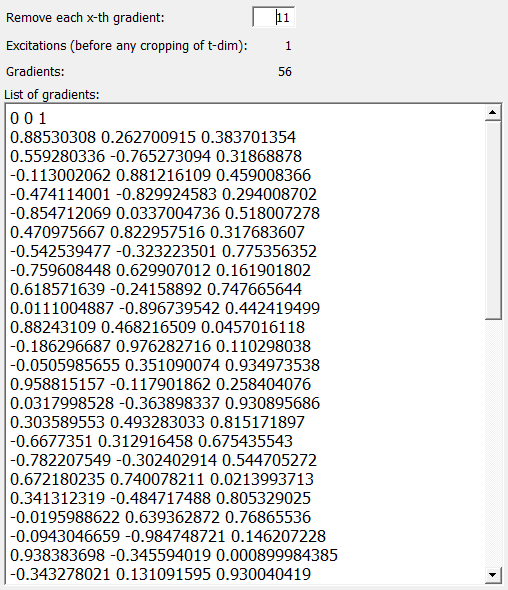DTIInfo¶
Purpose¶
The module DTIInfo displays the following information based on DICOM tags. Note that the full information will only be given for Siemens DTI data.
the number of excitations (NEX), also know as the number of repetitions, or number of measurements.
the number of gradients.
the scanner manufacturer.
the gradient scheme.
Usage¶
Connect image data to input. The gradients are automatically stored at the field “list of gradients”. You can directly use this list with DiffusionTensorAnalysis. Please note that you must first use the DecodeVendorSpecificDicomTags module (if the gradients have not already been saved in the private tag 0021,1013).
Tips¶
If using the SubImage to crop the t-dimension, the corresponding gradient information is not cropped. Furthermore, if using the DTIInfo, the number of excitations will also show the original number before cropping.
Windows¶
Default Panel¶

Input Fields¶
input0¶
- name: input0, type: Image¶
Diffusion weighed image.
Parameter Fields¶
Field Index¶
|
|
|
|
The module shows additionally the a list showing all gradient vectors.
Visible Fields¶
Gradients¶
- name: numberOfGradients, type: Integer, default: 0¶
Shows the number of gradients used during the acquisition process.
In other words, it shows the number of repetitions that have been made of the data.
Excitations (before any cropping of t-dim)¶
List of gradients¶
- name: gradients, type: String¶
List of gradient vectors sorted by x,y,z.
Remove each x-th gradient¶
- name: removeEachXthGradient, type: Integer, default: 0¶
Some newer diffusion-weighted sequences, e.g. from Philips, store intermediate B0 images during the DTI acquisition. Those B0 images are also attached with a gradient. However, the DiffusionTensorAnalysis module does not directly work with these kinds of data and gradient tables. Thus, this option easily allows for removing each x-th gradient which might correspond to an intermediate B0 image.